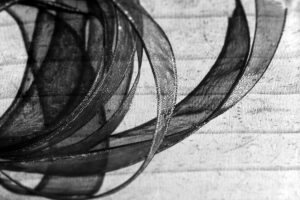Kri’ah – Expressing Grief by Rending Garments
 Earlier this calendar year, Jewish Cemeteries of Greater Cincinnati hosted the program, “Traditions that Comfort: Jewish Customs of Mourning.” We are following up in this newsletter with a brief history and overview of the customs of kri’ah ((קְרַ֖ע, also spelled Keriah, kriah, and k’riah), or rending of cloth. This is the most visible sign of mourning for a Jew.
Earlier this calendar year, Jewish Cemeteries of Greater Cincinnati hosted the program, “Traditions that Comfort: Jewish Customs of Mourning.” We are following up in this newsletter with a brief history and overview of the customs of kri’ah ((קְרַ֖ע, also spelled Keriah, kriah, and k’riah), or rending of cloth. This is the most visible sign of mourning for a Jew.
In Hebrew, kri’ah means to tear, or rend, and the history of kri’ah is the tradition of rending or tearing a garment when in mourning for a loved one. While Maimonides (Rambam), in around 1100 CE, wrote “the Torah commands us to mourn when our relatives die” (Maimonides, Yad, Avel 1:1), there is no biblical commandment to rend our clothes as an outward expression of our pain and mourning. However, Torah does provide us with powerful examples of how our forebears mourned, and these examples guide our Jewish practice of mourning even today.
Our first example of this is in Genesis 37:29, when Reuben returned to the pit into which his brothers had thrown Joseph. Upon finding his brother gone, he tore his clothes. Shortly after that, believing that his son Joseph had been torn by a beast, Jacob is overcome by grief and also tore his clothes (Genesis 37:34). In Leviticus, after the death of Aaron’s sons Nadab and Abihu, Moses tellingly forbids Aaron and two of his other sons, Eleazar and Itamar, “do not bare your heads and do not rend your clothes” (Lev 10:6), which indicates that kri’ah was perhaps common practice by that time.
In Talmud, kri’ah was traditionally done upon hearing of the death of a parent, spouse, sibling or child. Kri’ah is performed while standing. According to the Jerusalem Talmud, Moed Katan, this custom arises from the actions of Job; upon hearing of the death of his children, “Job rose, tore his coat and threw himself on the ground …” (Job 1:20).
The Talmud also outlines that the tear must be on the outermost garment, near the neck, on the front. If mourning a parent, the kri’ah is done on the left side, or over the heart. If mourning the other close relatives halakhically commanded, then the kri’ah is on the right side. Kri’ah is performed with the accompanying blessing, “Baruch atah Adonai, Eloheinu Melech haOlam, dayan haemet.” (Blessed are you Adonai, Ruler of the universe, the True Judge.) This important ritual is usually completed just before the funeral or at graveside. Kri’ah will be worn during the period of shiva.
Today, the Orthodox practice is to tear one’s clothes. In a modern adaptation, many Reform Jews will pin a torn black ribbon on their clothes, where the tear would be.
Judaism is a physical faith – we express our beliefs through deeds and actions. The tearing of one’s clothes can serve as a release, a symbolic expression of the pain the death of a loved one has brought upon us. The halakhic requirement is to “expose the heart” (Shulchan Arukh 195:4). In performing kri’ah, we acknowledge our pain and enter into the grieving process. This tear creates a very real opening for grief to pass through and for the love and support of one’s family and community to enter. It also symbolizes the broken heart of the mourner that lies below. Kri’ah may also serve as a substitute for the ancient and pagan customs of tearing the flesh and the hair, symbolizing the loss of one’s own flesh and blood. Gashing oneself in response to death is outlawed in Deuteronomy 14:1.[1]
Experiencing the death of a loved one is “the crisis of life.”[2] Grieving has no set process or timetable. How we address our pain of loss is both intensely personal and supported by Jewish tradition and rituals. The symbol and ritual of kri’ah can help us articulate our feelings and give us focus in a time of upheaval.
Edie Yakutis is a 5th Year Rabbinic Student at HUC-JIR, serving as the TJF Intern, with the Jewish Cemeteries of Greater Cincinnati.
[1] Lamm, Maurice, “The Jewish Way in Death and Mourning”.
[2] Lamm, Ibid

